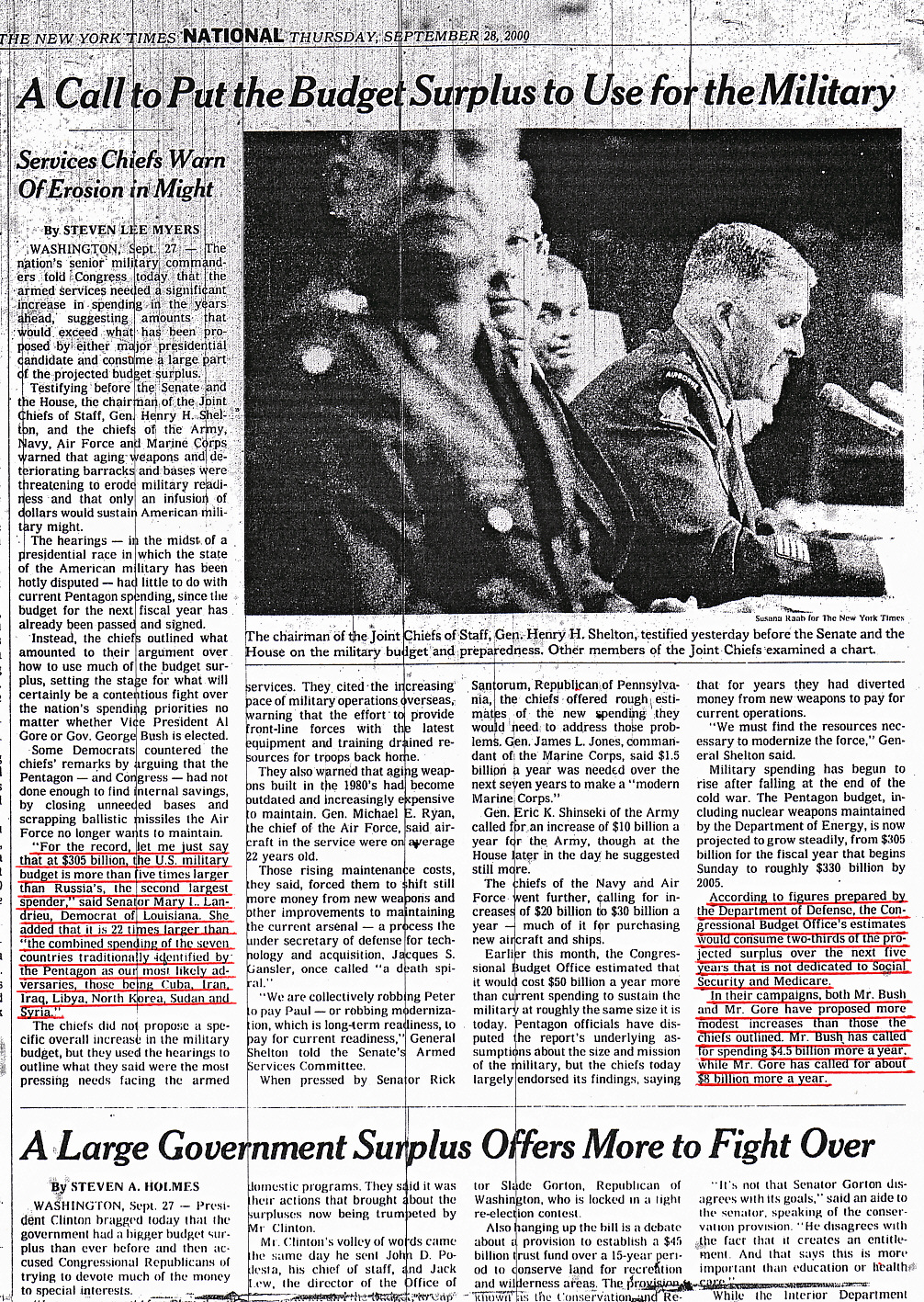

By STEVEN LEE MYERS
WASHINGTON, Sept. 27--The nation's senior military commanders told Congress today that the armed services needed a significant increase in spending in the years ahead, suggesting amounts that would exceed what has been proposed by either major presidential candidate and consume a large part of the projected budget surplus.
Testifying before the Senate and the House, the chairman of the Joint Chiefs of Staff, Gen. Henry H. Shelton, and the chiefs of the Army, Navy, Air Force and Marine Corps warned that aging weapons and deteriorating barracks and bases were threatening to erode military readiness and that only an infusion of dollars would sustain American military might.
The hearings--in the midst of a presidential race in which the state of the American military has been hotly disputed--had little to do with current Pentagon spending, since the budget for the next fiscal year has already been passed and signed.
Instead, the chiefs outlined what amounted to their argument over how to use much of the budget surplus, setting the stage for what will certainly be a contentious fight over the nation's spending priorities no matter whether Vice President Al Gore or Gov. George Bush is elected.
Some Democrats countered the chiefs' remarks by arguing that the Pentagon--and Congress--had not done enough to find internal savings, by closing unneeded bases and scrapping ballistic missiles the Air Force no longer wants to maintain.
"For the record, let me just say that at $305 billion, the U.S. military budget is more than five times larger than Russia's, the second largest spender," said Senator Mary L. Landrieu, Democrat of Louisiana. She added that it is 22 times larger than "the combined spending of the seven countries traditionally identified by the Pentagon as our most likely adversaries, those being Cuba, Iran, Iraq, Libya, North Korea, Sudan and Syria."
The chiefs did not propose a specific overall increase in the military budget, but they used the hearings to outline what they said were the most pressing needs facing the armed services. They cited the increasing pace of military operations overseas, warning that the effort to provide front-line forces with the latest equipment and training drained resources for troops back home.
They also warned that aging weapons built in the 1980's had become outdated and increasingly expensive to maintain. Gen. Michael E. Ryan, the chief of the Air Force, said aircraft in the service were on average 22 years old.
Those rising maintenance costs, they said, forced them to shift still more money from new weapons and other improvements to maintaining the current arsenal--a process the under secretary of defense for technology and acquisition, Jacques S. Gansler, once called "a death spiral."
"We are collectively robbing Peter to pay Paul--or robbing modernization, which is long-term readiness, to pay for current readiness," General Shelton told the Senate's Armed Services Committee.
When pressed by Senator Rick Santorum, Republican of Pennsylvania, the chiefs offered rough estimates of the new spending they would need to address those problems. Gen. James L. Jones, commandant of the Marine Corps, said $1.5 billion a year was needed over the next seven years to make a "modern Marine Corps."
Gen. Eric K. Shinseki of the Army called for an increase of $10 billion a year for the Army, though at the House later in the day he suggested still more.
The chiefs of the Navy and Air Force went further, calling for increases of $20 billion to $30 billion a year--much of it for purchasing new aircraft and ships.
Earlier this month, the Congressional Budget Office estimated that it would cost $50 billion a year more than current spending to sustain the military at roughly the same size it is today. Pentagon officials have disputed the report's underlying assumptions about the size and mission of the military, but the chiefs today largely endorsed its findings, saying that for years they had diverted money from new weapons to pay for current operations.
"We must find the resources necessary to modernize the force," General Shelton said.
Military spending has begun to rise after falling at the end of the cold war. The Pentagon budget, including nuclear weapons maintained by the Department of Energy, is now projected to grow steadily, from $305 billion for the fiscal year that begins Sunday to roughly $330 billion by 2005.
According to figures prepared by the Department of Defense, the Congressional Budget Office's estimates would consume two-thirds of the projected surplus over the next five years that is not dedicated to Social Security and Medicare.
In their campaigns, both Mr. Bush and Mr. Gore have proposed more modest increases than those the chiefs outlined. Mr. Bush has called for spending $4.5 billion more a year, while Mr. Gore has called for about $8 billion more a year.
(article accompanied by [Susana Raab for the New York Times] photograph of General Henry H. Shelton and other members of the U.S. Joint Chiefs of Staff, captioned:
The chairman of the Joint Chiefs of Staff, Gen. Henry H. Shelton, testified Wednesday before the Senate and the House on the military budget and preparedness. Other members of the Joint Chiefs examined a chart.)
(text of September 28, 2000 New York Times On The Web editorial)
![]() *-IF VISITORS TO THIS PAGE HAVEN'T COME FROM THE ONE RECALLING PERHAPS THE MOST OFTEN QUOTED STATEMENT EVER MADE BY FORMER U.S. PRESIDENT DWIGHT D. EISENHOWER, THEN TAKE A BRIEF SIDESTEP HERE AND COME BACK HERE.
*-IF VISITORS TO THIS PAGE HAVEN'T COME FROM THE ONE RECALLING PERHAPS THE MOST OFTEN QUOTED STATEMENT EVER MADE BY FORMER U.S. PRESIDENT DWIGHT D. EISENHOWER, THEN TAKE A BRIEF SIDESTEP HERE AND COME BACK HERE.
BACK?
I AM NOT GOING TO COMMENT ON THIS BEYOND SUGGESTING, WITH THAT EISENHOWER ANALYSIS AND THIS ANNOTATED TERM OF REFERENCE IN MIND, THAT VISITORS TO MY AWARD-WINNING WEBSITE TAKE YOUR NEXT FOOTSTEP HERE.